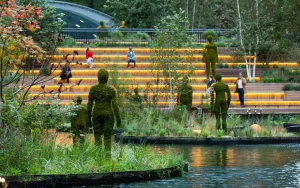There was a time when ‘biodiversity’ was something you only ever heard properly in nature documentaries, grumbling over footage of some beleaguered frog. Now, though, it’s all much closer to home.
Developers, planners, and anyone with an interest in altering so much as a hedge are being asked—no, instructed—to not only preserve biodiversity but to increase it. Enter Biodiversity Net Gain (BNG), a concept that’s more about giving back than tree hugging. The idea is simply that, after the excavators have come and gone, there’s more nature standing than initially existed.
It sounds sweet in principle. A happy compromise between development and nature preservation, in which buildings may go up and roads can be widened, but only if something green and growing is given back in return. But in practice, for most firms, it sits somewhere between bureaucratic hell and logistical calamity. Not that anyone is ever saying so aloud, of course—aloud, everyone is overjoyed at the opportunity to ‘give something back to nature’ (a phrase which, by the way, leads nature to feel like an exhausted friend who always picks up the bill). The reality, however, is a bit more complicated. For businesses struggling with these new rules, it’s more a matter of keeping the wheels turning and staying out of regulators’ hair than making giant-scale ecological gestures. And that’s where things get interesting.
BNG and the Delicate Art of Compliance
For the newcomer to the subject, BNG is a law calling for new development to lead to a net gain for biodiversity, rather than simply replacing what was there before. It’s not just a question of not damaging but positively adding to the ecological value of the land. It’s a concept that, when first proposed, probably made a few developers spit out their coffee. Those are the days gone by when the planting of a symbolic tree in a supermarket car park would be enough to placate environmental concerns. Now, there are measurements, metrics, and a whole system of calculations to ensure that, whatever is lost, something better (or at least as good) is put in its place.
It means that businesses—particularly land development, construction, and infrastructure businesses—can no longer afford to treat biodiversity as a footnote in their planning applications. It needs to be addressed from the outset, not merely as an obstacle to be negotiated, but as a part of project viability. And of course it’s easy for me to say. Now there are habitat valuations, biodiversity units to count, and strategies to be formulated that will satisfy local planning authorities. It’s light years from when the only ‘environmental influence’ most development cared about was whether there was going to be sufficient parking facilities.
For anyone who’s just a bit short of breath over the whole enterprise, there is a way of simplifying life. Computer programmes, for instance, can facilitate the process so that all those calculations are calculated without the hassle of endless spreadsheet or more plaintive calls on ecological consultants. You can find solutions tailored to your specific needs and avoid some of the more common pitfalls that tend to derail projects. Because if there’s one thing worse than having to comply with BNG, it’s realising too late that you’ve done it incorrectly.
The Realities of Implementing BNG in Development
So, what does this all look like in practice? Well, for most, it’s a question of how to ‘balance out’ the impact of a project—hopefully without the accompanying six-month delay or falling out with the planners. Some turn to on-site measures, integrating green roofs, wildlife corridors, and wetlands into their projects. Others take the off-site option, creating elsewhere habitats to counter losses. Either way, it’s another level of sophistication that has to be managed from day one.
And yet, if handled correctly, BNG can be something more than just another obstacle to overcome. There are genuine chances for firms to improve their reputations, ease planning permission, and even bring out more cash for green schemes. For, although regulators have the stick in hand, there’s a carrot here too: the chance to future-proof business in a future where environmental adherence is not only a matter of law but one of business necessity.
Of course, nobody is proposing that it’s easy. BNG comes with its own set of baggage—unanticipated costs, added surveillance, and the requirement of sitting down with ecological experts who have a right-out creepy enthusiasm for moths. And then there’s enforcement. While the law is nicely constructed on paper, the question of how aggressively it will be enforced remains to be seen. A few planning authorities will be inflexible, demanding stringent adherence to targets for biodiversity. Others will relax a bit and see BNG as a reference rather than divine instruction. What’s important is to be prepared for either.
Long-Term Benefits (and a Few Lingering Grumbles)
If there is a silver lining to this, it is that businesses which take BNG seriously now will be much better off in the future. When environmental regulations keep getting tougher and tougher, companies which have biodiversity considerations built into their projects from the outset will be at the front of the pack, rather than trying to catch up. And while the initial cost and disruption are infuriating, the advantages in the longer term—faster planning permission, improved corporate reputation, and smoother stakeholder management—are not to be sniffed at.
All the same, it would be untrue to suggest that all developers are jumping for joy about BNG. There are complaints—loads of them—regarding increased complexity, expense, and the manner in which meeting biodiversity conditions occasionally feels more akin to finding your way through a conservationist-created obstacle course than it does conducting a bit of ecological survey work. But such as it is, BNG isn’t disappearing. It’s here, it’s binding, and it’ll be the businesses that find out how to master it successfully who’ll emerge top.

